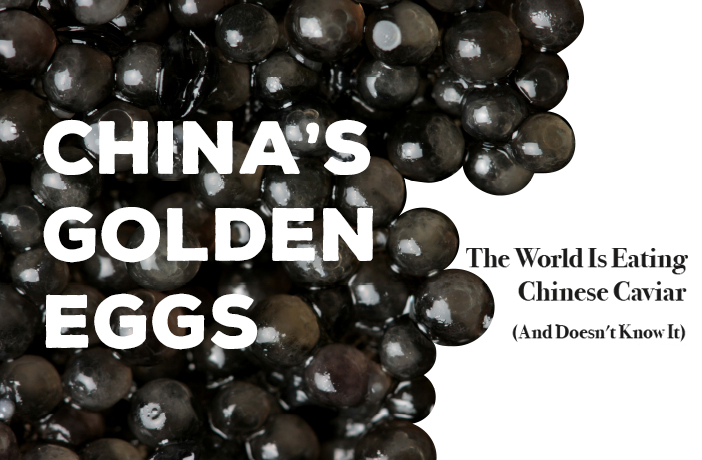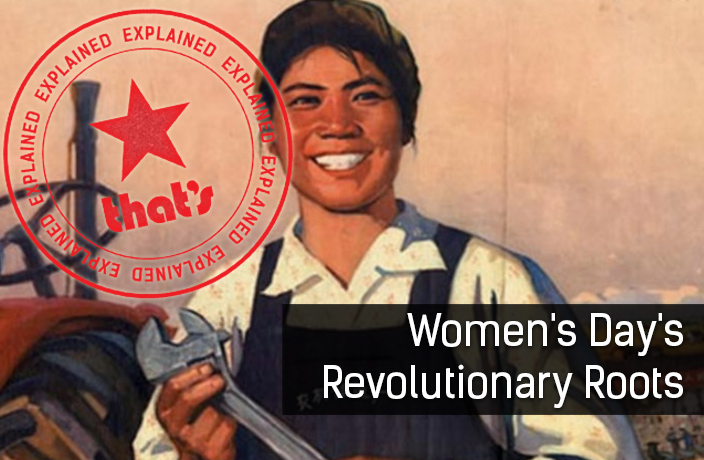I must have heard this story five times. I’m only one day into my press trip, and yet multiple Kaluga Queen reps have recounted it already. Now here we go again. I’m in a group of 25 journalists gathered around a dinner table overlooking Zhejiang’s scenic Qiandao Lake, and company Vice President Xia Yongtao spies an opportunity. Naturally, he begins:
“Lufthansa airlines did a blind taste test, and out of the 13 caviars they tried from around the world…,” he says. Everyone liked Kaluga Queen’s the best, I know, I think. The story continues. “Later, Lufthansa did another taste test, just to be sure.” Again, he says, every single person picked Kaluga Queen as their favorite.
That was 2011. Today, Kaluga Queen caviar comes standard in Lufthansa first-class cabins. The company has become the largest producer of caviar in China, and the third largest in the world. Xia tells us all this, then holds up his glass of wine.
“Cheers,” he says. We all raise our glasses to Kaluga Queen.

Kaluga Queen is hugely successful. And yet, the company is in many ways still a little fish in a big pond. Because while China's caviar industry is exploding, the country's producers face an uphill battle as they try to convince the international community that the best sturgeon roe in the world are, well – 'made in China.'
I suppose that’s why I’m here. Those in the fine dining industry know of China’s caviar domination, but diners still don’t.
“People in the industry, of course, know,” says Dominique Martinez, executive chef of The Peninsula Beijing. “But people outside the industry are always surprised to learn that China makes the best caviar.”
Ask a diner to name where her caviar originates, and chances are she’ll say Iran or Russia. There’s some truth to this – the first record of humans eating sturgeon roe is 2,000 years ago in Persia, but caviar really gained prestige in the 18th century, when Catherine the Great served it at palace banquets. From then on, caviar became synonymous with Russian royalty, and when the country’s aristocrats fled the Bolshevik Revolution, the expatriates made the delicacy popular in Paris. Today, 21 of Paris’ 26 Michelin-starred restaurants use Kaluga Queen caviar.
Caviar’s recent history is more fraught. When the Soviet Union collapsed, the Caspian Sea – then rich with wild sturgeon – reopened for fishing. It was largely pilfered as a result. In 2000, the Convention on International Trade in Endangered Species (CITES) classified sturgeon as endangered, and soon after, it banned the fishing of wild sturgeon altogether.
With the world’s most famous caviar-sourcing waters now off-limits, producers looked for new places to raise sturgeon. China’s cheap land and labor beckoned. But starting a sturgeon farm isn’t easy – sturgeon usually take a decade or more to sexually mature.
“This is why there’s an explosion, and almost an oversupply of caviar in the world right now – a lot of the farms that were set up in the 90s or early 2000s are now coming to maturity,” says Toby Collins, co-owner of the Shanghai-based Black Pearl Caviar.

Qiandao Lake, Zhejiang province is where Kaluga Queen sturgeon are raised
I’m seeing proof of this in Qiandao, Zhejiang province, home to Kaluga Queen’s extensive farming operations. I’m here to meet these first-class fish, as are a slew of Singapore-based food writers and an American camera crew – a member of which is rather unfortunately wearing a qipao and Uggs. It’s raining hard, and we are all handed lemon-yellow ponchos. We waddle like rubber ducks down to a fleet of motorboats at the lakeside dock.
It takes half an hour by boat to reach the farm, across pristine waters. Kaluga Queen rep Cai Leqiao tells me that, on a clear day, you can see 7 meters deep. The lake sits among the jaw-dropping foothills of the famed Huangshan mountain range. Any skepticism we harbor toward pollution-ridden China producing clean caviar evaporates when we see the farm’s surroundings.
In an effort to boost Chinese caviar’s international image, Kaluga Queen flies everyone from journalists to chefs to KOLs to its farm, and then wows them with a series of impressive facts throughout the trip. A select few: Kaluga Queen scientists use ultrasound technology to monitor pregnant sturgeon bellies. Superstar French Chef Alain Ducasse uses Kaluga Queen at his three-Michelin-star restaurant in Monaco. Kaluga Queen was the official caviar supplier for the 2016 G20 summit. Michelle Obama tried Kaluga Queen and liked it. (There was a PowerPoint; I could go on.)

A fisherman checks up on sturgeon on Kaluga Queen's Qiandao farm
They are wise to bring us here. Qiandao’s beauty is stupefying. At the docks, we spy the graceful beasts lurking below us as Xia explains fishermen's duties, and then we take turns holding an unhappy sturgeon, posing for pictures with her in our hands. All in all, it gives a splendid impression of China’s fine foods industry. And this is exactly the point.
Qiandao is lovely when you see it, but most people don’t get this far. For Kaluga Queen marketing manager Lily Liu, that’s a problem.
“To be honest, it takes time to increase the international image of Chinese food, even today,” she says. “The biggest obstacle is the low image of, and low trust in, Chinese food safety.”
This is why she and the Kaluga Team have flown us all here – seeing is believing. Or as Liu says: “Quality talks.”
Quality can talk all it wants – but what does it matter if no one’s listening? When Toby Collins started his caviar brand in 2006, many were simply unwilling to buy caviar made in China, no matter how good it was. “There was a stigma,” he says. “China has not had the world’s best reputation for quality controls and sustainable farming.”
Collins went to painstaking efforts to find the perfect farm and settled on a beautiful one in Hubei – naturally filtered and sustainable. His business partner had extensive experience working for the prestigious American caviar company, Tsar Nicoulai. Even still, customers were hesitant. So Collins tried a strategy many of China’s caviar companies still employ: Appearing as Western as possible.
“When we started, the Black Pearl Caviar brand was deliberately designed to avoid seeming like it’s Chinese,” he says. In sales meetings, Collins’ Russian colleague played up the caviar’s Russianness. “She would say, ‘actually they’re not Chinese caviar – it’s Russian sturgeon, farmed in China. So basically they’re expats. They’re expat sturgeon.’”
Collins is not alone in this. Many Chinese luxury companies rely on the endorsement of Western brands. This is why China’s robust caviar industry – which produces 60 percent of the world’s caviar – remains relatively unknown among consumers.
In the Beijing offices of Chinese brand Caviar & Traditions, founder John Zheng leads me through a tasting of three varieties of – uniformly delicious – roe. Then he points to one of his tins and says: “See this. It says, ‘Chinese Caviar, French Touch.’” But a photo of the same product on Sinodis.com, Caviar & Traditions’ distributor, doesn’t have the “Chinese” bit. It simply reads, “Caviar & Traditions, French Touch.”
Search the website of the world’s most famous caviar vendor – Petrossian – for the word “Chinese,” and you’ll find only a set of tea leaves. Of course, Petrossian and other vendors are legally required to say where their caviar is made when asked, and several brands have “Origin: Chinese” written in tiny, light-gray letters near the product info.
But no one is in a rush to claim their caviar is Chinese.
“If [our caviar] was from Iran, we’d be like, ‘This is Iranian beluga!’” says Collins. And while reception to Chinese-made roe is improving, “We still don’t stamp it with big letters.”
But change is coming. Or, at least, that’s what Kaluga Queen hopes. At its processing plant in Quzhou, a couple hours from the lake, one of the reporters is live-streaming our factory tour. I am avoiding the gaze of her selfie stick as best I can.
Because while caviar eating may be glamorous, caviar producing is decidedly unsexy. I’m forced to wear an oversized labcoat, boots, hairnet and face mask. I look like I’m about to perform surgery. I also look fat.
Armed with my camera and 20 pounds of excess fabric, I enter what is essentially a gallows for fancy fish. Sturgeon carcasses hang upside-down on metal hooks, pools of blood just beneath them. A stench hangs about the room. We snap some photos, but Kaluga Queen reps are eager for us to move on. They’re happier to let us linger in the final room, where the eggs are already separated from their dead mothers and are being packaged.

Left: A factory worker removes roe from a sturgeon womb; Right: Sturgeon carcasses hang at Kaluga Queen's processing plant in Quzhou, Zhejiang province
I then watch, mesmerized, as a factory worker unceremoniously slices open the sturgeons’ long bodies with a single blade stroke. She scoops out the tiny eggs by the fistful, thousands of glistening ova from every womb. It’s magical to see a smelly corpse open up to reveal the world’s most luxurious food product.
Sure, there is a lot of money in these eggs. But there is also a fair bit of gore. Internationally, much ado has been made of the ethical concerns of caviar. In December, an educational video on caviar production went viral, simply because it was gross. (“Caviar – Further exploitation of & violence towards females' bodies in our collective misogynistic-carnist society,” wrote one Facebook commenter.)

And yet, today’s caviar production is more ethical than ever. The rise of farmed sturgeon means that fewer of the endangered wild ones are poached, and also, possibly, better caviar: The more sturgeon farms develop, the more they can control the growth of their fish. And China is leading this charge.
John Zheng is a pioneer of sturgeon breeding. After earning his doctorate in marine biology, he started farming sturgeon in a direct reaction to the CITES wild-fishing ban. Zheng spent years as a researcher for the Chinese Academy of Fishery Sciences perfecting sustainable aquaculture – something he thinks China does quite well.
His company, Caviar & Traditions, has a farm in Hunan, not far from the province’s famous Zhangjiajie scenic area. Zheng started the company in 2006 as a joint venture with a French producer – hence the alleged ‘French Touch.’
It’s a win-win relationship. Caviar & Traditions can benefit from the prestige of partnering with a French brand; the French brand can produce caviar more cheaply, thanks to lower production costs in China. Ultimately, this plays an important part in Chinese caviar’s rise: Farmland is cheap.
But Chef Dominique Martinez says it’s not an issue of cost for him. “I will never compromise quality,” he says. His reason for using Chinese caviar is simple: It’s the best.
Martinez buys his caviar from W3, a company with farms in Sichuan that also supplies to celebrity-chef Joel Robuchon’s restaurants. At The Peninsula’s farm-to-table restaurant, Jing, the caviar’s origin is written on the menu.
W3 chooses eggs specifically for Martinez, and then packages them with The Peninsula stamp on them. Martinez sees this as a way of endorsing Chinese caviar. After all, he reasons, he wouldn’t want to have anything of low quality bearing his company’s brand.
The Peninsula Shanghai, meanwhile, uses Kaluga Queen caviar. And after a day of touring farming and processing facilities, it’s finally time to taste it.

First, we are all handed tiny mother-of-pearl spoons, and instructed to scoop little piles of caviar onto the back of our hands. (Metal spoons are said to interact unfavorably with the taste of caviar; if you are such a peasant as to not own a mother-of-pearl spoon, then go find a wooden one.) When we place the eggs on our tongues, we are instructed to push the little orbs to the roof of our mouths. Low-quality caviar will turn to mush with the pressure; high-quality caviar will pop. Kaluga’s pops.
The caviar is exquisite – even if I still believe the global fervor for these rich-people eggs is a little overblown. Nonetheless, I’m struck with a sense of injustice.
By all accounts, Kaluga Queen’s operation is impressive. And yet they have to be impressive – the most impressive – if they’re to be successful in a European-dominated luxury market.
Qipao-and-Uggs lady muses aloud that she didn’t know a Chinese caviar production this sophisticated would even be possible.
“Yeah,” says a Kaluga rep. “If people could just come and see all this, they’d understand.”
One day, they will. For China’s caviar industry is only growing larger. Collins says the stigma against Chinese caviar has improved in recent years, and he believes it will continue to do so. In China, he says: “Since 2009 to now, it’s exploded – there’s double-digit growth every year, and we’ve seen so many restaurants and hotels adopt caviar.”
China just may be saving the caviar industry from ruin. In an era in which consumers in the West are turning their backs on sturgeon as they wake up to eco-conscious cuisine, many in the East are just discovering it.

At the moment, the vast majority of caviar produced in China is exported abroad – primarily to Europe. But Chinese consumers are growing to appreciate it, too.
“We want to sell more caviar in China,” says Zheng, who believes that he will, given time. “More and more people enjoy new foods, like cheese and wine,” he says, giving Pizza Hut as an example of where all the young Chinese cheese lovers go.
Zheng’s colleague Kang Mei, in marketing and sales, faces the difficult task of convincing Chinese consumers to drop a few hundred kuai on tiny, expensive eggs they might not have heard of before.
Some of her marketing techniques work better than others – “before I began eating caviar, I used to have spots on my face, like you,” she says, pointing at a patch of acne on my chin. But her main strategy is one I can get behind. Kang uses WeChat to educate potential clients as to caviar’s historical significance. Rather eloquently, she calls sturgeon “living fossils in the water.” (As Zheng later tells me, sturgeon have been on Earth for over 200 million years. “The fact that this kind of animal can still survive on Earth, it’s amazing,” he says.) She uses her platform to tell tales of the Russian court, the Parisian Belle-Époque, the modern world of high-flying caviar enthusiasts.
These are, after all, resilient little eggs. They’ve survived the fall of Russian monarchy; world wars; the Industrial Revolution; the fall of the Soviet Union; the looming threat of their own extinction. There’s a lot of inspiration to be taken from their long, storied past. Zheng believes caviar is best served with a history lesson (and also technically a mother-of-pearl spoon).
“It’s a topic of conversation on the table,” he says. “Behind food, there is a story.”
It’s a story in which he – and thousands across the country – believes China will write the next chapter.






















0 User Comments